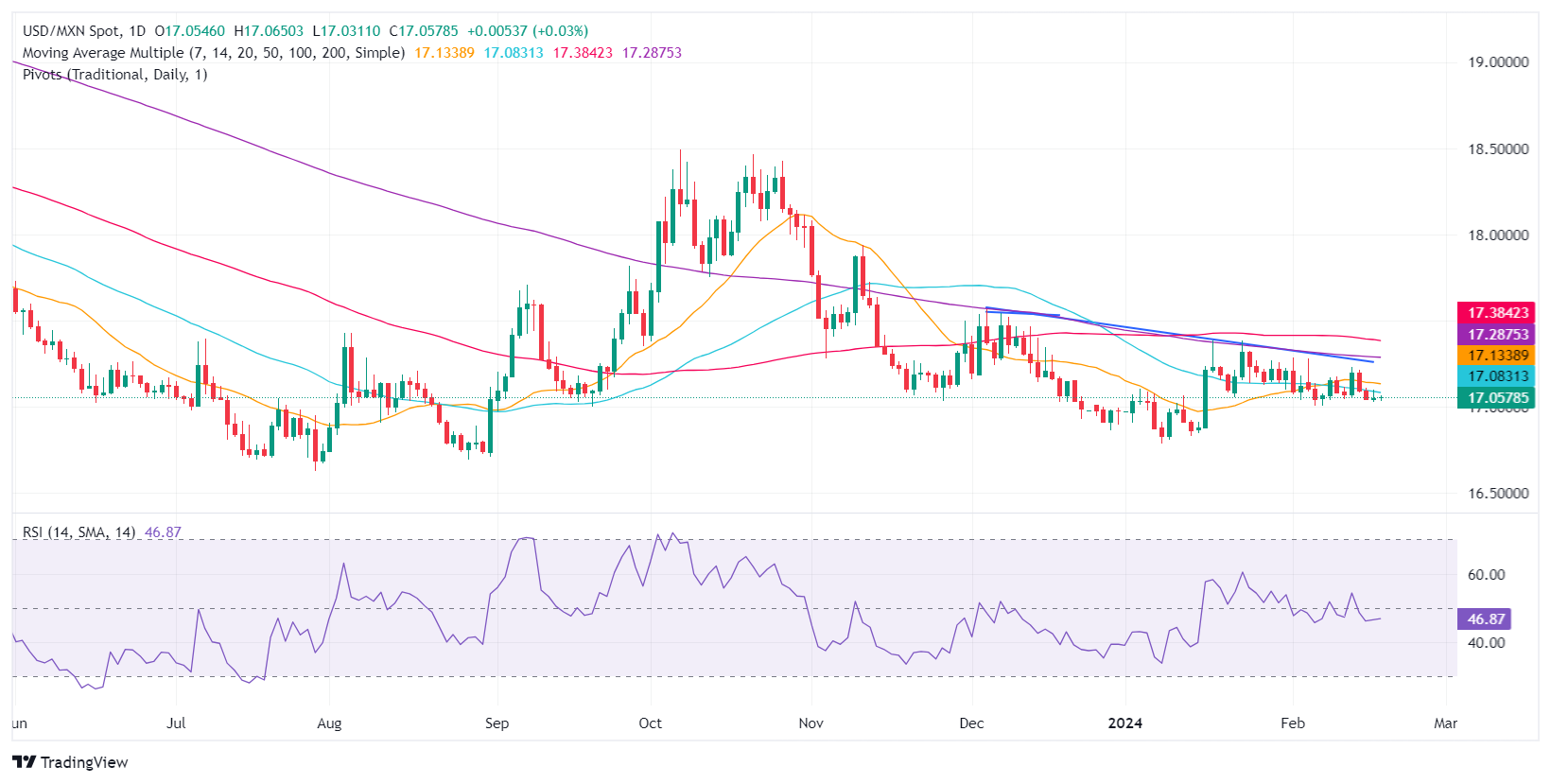Most recent article: Mexican Peso tumbles on Tuesday ahead FOMC minutes release
- Mexican Peso remains steady as low trading volume marks US Presidents’ Day.
- Mexico's IOAE indicates a -0.7% MoM contraction with a modest 1.3% annual growth in early 2024.
- US-Mexico trade disputes over steel and aluminum exports could impact the Peso's future stability.
The Mexican Peso seesaws against the US Dollar on Monday as low volume trading is due to the United States observing Presidents’ Day. The Indicator of Economic Activity (IOAE), which provides preliminary readings on a monthly basis, suggests the Mexican economy most likely contracted in January 2024. The USD/MXN trades at 17.05, almost flat, at the time of writing.
Mexico’s National Statistics Agency (INEGI) revealed the IOAE contracted -0.7% MoM. In annual comparison, the economy most likely grew by 1.3% at the beginning of 2024. Late in the week, Mexico’s economic schedule will feature Retail Sales, the Gross Domestic Product (GDP) for Q4 2023 and the mid-month inflation report in February.
The USD/MXN remains weak, accumulating losses of 0.59% in year-to-date (YTD) figures. Nevertheless, pressure from the US regarding Mexico’s exports of steel and aluminum, along with implicit risks of the general election, threaten to derail the Mexican currency.
US trade representative Katherine Tai warned Mexico that the US could reimpose tariffs on imports of the aforementioned commodities if the Mexican Government, led by Andres Manuel Lopez Obrador (AMLO), fails to take urgent measures to stop the increase in exports. US authorities question Mexico’s lack of transparency on imports of steel and aluminum from third countries.
Daily digest market movers: Mexican Peso unchanged as trading liquidity drains on US holiday
- Mexico’s economic schedule will feature Retail Sales on February 21, expected to rise 0.2% MoM in December and 2.5% YoY.
- On February 22, the Mexican economy is projected to have grown 0.1% in Q4 2023 and 2.4% YoY. Mid-month underlying inflation for February is estimated to slow from 4.78% to 4.67 YoY, while is projected to drop from 4.9% to 4.7%.
- Across the border, the US economic docket will feature the release of the latest Federal Reserve Open Market Committee (FOMC) Minutes alongside Fed officials crossing the wires.
- Traders will get further cues from US S&P Global PMIs, Initial Jobless Claims data and the Chicago Fed National Activity Index, usually a prelude of the Institute for Supply Management (ISM) Manufacturing PMI.
- Last Friday, prices paid by producers exceeded forecasts, which means the Personal Consumption Expenditures (PCE), the Fed’s preferred gauge for inflation, could aim higher in February.
- Consumer sentiment in the US improved slightly to 79.5 from 79.0 in January’s last reading, according to the University of Michigan Survey. Analysts foresaw an improvement to 80.0 on its preliminary reading.
- Inflation expectations in the US remained steady, with one-year inflation at 3%, up from 2.9%, while for a five-year period it stood unchanged at 2.9%.
- Fed’s Bostic said patience is required and he foresees two rate cuts, which could begin in the summer if the data justifies it. Fed’s Daly said, “We will need to resist the temptation to act quickly when patience is needed and be prepared to respond agilely as the economy evolves.”
- Market players are expecting the first rate cut by the Federal Reserve at the June monetary policy meeting as they have trimmed odds for March and May.
Technical analysis: Mexican Peso is virtually unchanged as USD/MXN hovers circa 17.05
The USD/MXN seesaws near the 17.05 mark, below the 50-day Simple Moving Average (SMA) at 17.09. Even though that favors further downside, sellers must drag the exchange rate below the 17.00 figure if they would like to remain hopeful of challenging last year’s low of 16.62.
Otherwise, if buyers reclaim the 50-day SMA, followed by the latest cycle high of 17.22, that will expose the 200-day SMA at 17.29. A decisive break and the USD/MXN could rally toward the 100-day SMA at 17.39, followed by the 17.50 area. Buyers will eye a re-test of the 18.00 mark.
USD/MXN Price Action – Daily Chart
Mexican Peso FAQs
What key factors drive the Mexican Peso?
The Mexican Peso (MXN) is the most traded currency among its Latin American peers. Its value is broadly determined by the performance of the Mexican economy, the country’s central bank’s policy, the amount of foreign investment in the country and even the levels of remittances sent by Mexicans who live abroad, particularly in the United States. Geopolitical trends can also move MXN: for example, the process of nearshoring – or the decision by some firms to relocate manufacturing capacity and supply chains closer to their home countries – is also seen as a catalyst for the Mexican currency as the country is considered a key manufacturing hub in the American continent. Another catalyst for MXN is Oil prices as Mexico is a key exporter of the commodity.
How do decisions of the Banxico impact the Mexican Peso?
The main objective of Mexico’s central bank, also known as Banxico, is to maintain inflation at low and stable levels (at or close to its target of 3%, the midpoint in a tolerance band of between 2% and 4%). To this end, the bank sets an appropriate level of interest rates. When inflation is too high, Banxico will attempt to tame it by raising interest rates, making it more expensive for households and businesses to borrow money, thus cooling demand and the overall economy. Higher interest rates are generally positive for the Mexican Peso (MXN) as they lead to higher yields, making the country a more attractive place for investors. On the contrary, lower interest rates tend to weaken MXN.
How does economic data influence the value of the Mexican Peso?
Macroeconomic data releases are key to assess the state of the economy and can have an impact on the Mexican Peso (MXN) valuation. A strong Mexican economy, based on high economic growth, low unemployment and high confidence is good for MXN. Not only does it attract more foreign investment but it may encourage the Bank of Mexico (Banxico) to increase interest rates, particularly if this strength comes together with elevated inflation. However, if economic data is weak, MXN is likely to depreciate.
How does broader risk sentiment impact the Mexican Peso?
As an emerging-market currency, the Mexican Peso (MXN) tends to strive during risk-on periods, or when investors perceive that broader market risks are low and thus are eager to engage with investments that carry a higher risk. Conversely, MXN tends to weaken at times of market turbulence or economic uncertainty as investors tend to sell higher-risk assets and flee to the more-stable safe havens.
Information on these pages contains forward-looking statements that involve risks and uncertainties. Markets and instruments profiled on this page are for informational purposes only and should not in any way come across as a recommendation to buy or sell in these assets. You should do your own thorough research before making any investment decisions. FXStreet does not in any way guarantee that this information is free from mistakes, errors, or material misstatements. It also does not guarantee that this information is of a timely nature. Investing in Open Markets involves a great deal of risk, including the loss of all or a portion of your investment, as well as emotional distress. All risks, losses and costs associated with investing, including total loss of principal, are your responsibility. The views and opinions expressed in this article are those of the authors and do not necessarily reflect the official policy or position of FXStreet nor its advertisers. The author will not be held responsible for information that is found at the end of links posted on this page.
If not otherwise explicitly mentioned in the body of the article, at the time of writing, the author has no position in any stock mentioned in this article and no business relationship with any company mentioned. The author has not received compensation for writing this article, other than from FXStreet.
FXStreet and the author do not provide personalized recommendations. The author makes no representations as to the accuracy, completeness, or suitability of this information. FXStreet and the author will not be liable for any errors, omissions or any losses, injuries or damages arising from this information and its display or use. Errors and omissions excepted.
The author and FXStreet are not registered investment advisors and nothing in this article is intended to be investment advice.
Recommended content
Editors’ Picks

AUD/USD: Bulls need to clear the 200-day SMA
AUD/USD treaded water around 0.6360 after once again faltering near recent tops in the 0.6440 zone, always on the back of the intense recovery in the US Dollar. In the meantime, positive headlines on the US-China trade front could help the Aussie stay in the upper end of the range for the time being.

EUR/USD strengthens above 1.1300 on gloomy Fed’s Beige Book
The EUR/USD pair edges higher to around 1.1335 during the early Asian session on Thursday. Mitigating concerns over potential tariff threats by US President Donald Trump exerts some selling pressure on the US Dollar.

Gold corrected extreme conditions, struggles around $3,300
Gold extended its decline on Wednesday, slipping below the $3,300 mark per troy ounce in response to reports from the media suggesting the Trump administration is weighing tariff reductions on Chinese goods, a news that revived hopes of easing trade tensions and reduced demand for the yellow metal as a safe-haven asset.

TRUMP meme coin rallies following announcement of President Trump's upcoming dinner with top 220 holders
Official TRUMP rallied 50% on Wednesday after the team behind the meme coin announced plans for its top 220 token holders to have a dinner with President Donald Trump in May. The announcement also included an extension of the token's initial unlock plan by an additional 90 days.

Five fundamentals for the week: Traders confront the trade war, important surveys, key Fed speech Premium
Will the US strike a trade deal with Japan? That would be positive progress. However, recent developments are not that positive, and there's only one certainty: headlines will dominate markets. Fresh US economic data is also of interest.

The Best brokers to trade EUR/USD
SPONSORED Discover the top brokers for trading EUR/USD in 2025. Our list features brokers with competitive spreads, fast execution, and powerful platforms. Whether you're a beginner or an expert, find the right partner to navigate the dynamic Forex market.




